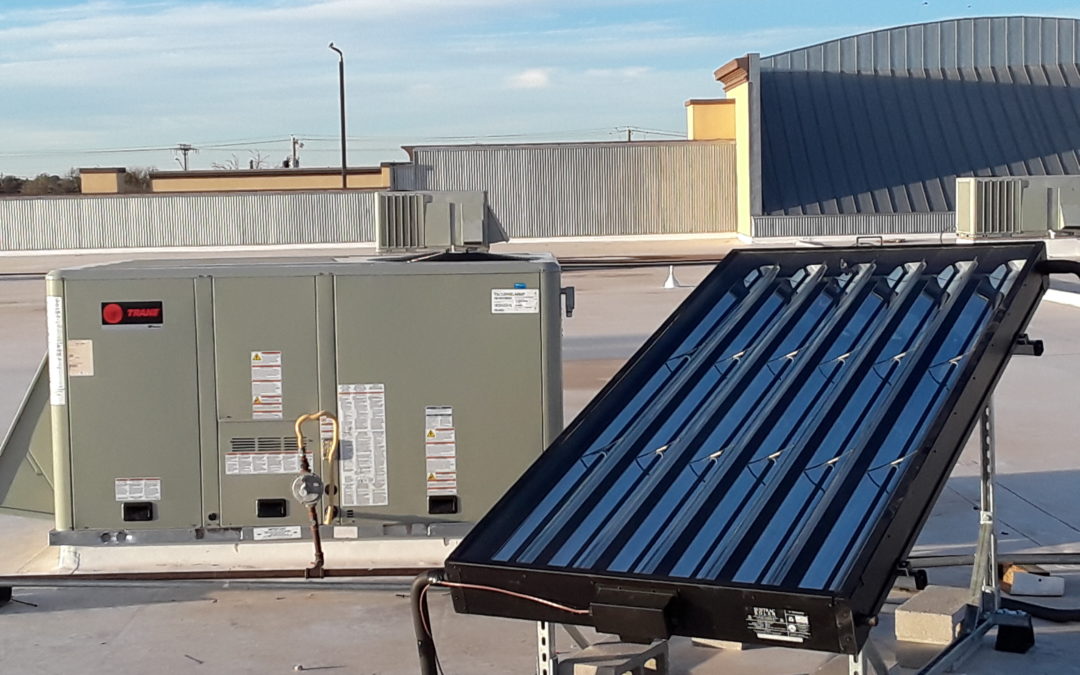HVAC Innovations and Insights
Equipment and software that goes further for efficient heating and cooling
(Pages 22-24. Jan/Feb 2016 Issue)
Article Excerp
Historically, hot sunny days have prompted many to turn on the air conditioning. These days, the sun’s rays are being used as a renewable energy source to run HVAC systems. It’s one of many innovative technologies on the market to provide energy-efficient operations.
For instance, in a recent commercial application, six SunTrac solar panels were installed on a 30-ton chiller system, which is expected to provide the building owner a return on investment in a little more than two years, and provide energy savings for more than 10 years.
SunTrac Solar Manufacturing has partnered with Emerson Climate Technologies/Copeland and KMC Controls to create renewable energy air and heat systems for commercial customers through upgrade, new, and replacement system options. The hybrid systems are designed to provide optimal efficiencies and low operating costs through the SmartPanel.
An air conditioner generates heat to remove heat. Recently introduced high-efficiency units feature two-stage, variable speed equipment. SunTrac technology is used to keep the two-stage compressor at low or at a first stage, low amperage drop and add supplemental heat to the system using the sun’s energy that would normally be added by the compressor’s second stage. And to do so with full BTU cooling output, says Mike Weinberger, SunTrac Solar’s Executive Vice President of Sales & Marketing.
While many solar panels can be used to add heat to refrigerant, controlling the temperature becomes a challenge, says Weinberger. Certain refrigerants operate at particular temperatures and pressures, he says, adding that a compressor can fail when the temperature is exceeded. The SmartPanel is used to dial in temperature requirements for a particular refrigerant. The SmartPanel uses Rite Temp sensor technology to control heat generated by the system, thus safeguarding the effectiveness and longevity of refrigerants and compressors. The system monitors and controls the pressure and heat added to the refrigerant, enabling it to maintain a steady temperature and ensuring system pressures are kept within optimal ranges, says Weinberger. That’s key in places with critical peak demand periods such as California. Southern California Edison is vetting the technology for a potential installation rebate program, he adds.
Although results vary depending on the compressor type, manufacturer, age, and condition, an integrated Smart- Panel can reduce compressor electricity consumption by up to 40%, says Weinberger.
Each SunTrac SmartPanel can sup- port up to 7.5 tons of compressor cooling capacity. For systems with more than one compressor, with each on a separate circuit, SunTrac adds additional Smart- Panels to the next circuit for an additional 25–40% electricity savings on that compressor, says Weinberger.“
For HVAC/R systems with compressors larger than 7.5 tons, SunTrac’s SmartPanels can be linked in series, accommodating HVAC/R units into the hundreds of tons,” he adds.
SunTrac’s Solar Hybrid HVAC/R System integrates with a variety of HVAC package units, chillers and refrigeration systems. It serves as a “mid-life” HVAC/R upgrade for commercial/ industrial units in which the HVAC/R contractor replaces worn compressors and/or upgrades the controller and adds the appropriate number of SmartPanels to the HVAC/R unit, says Weinberger.
SunTrac systems are scalable, and panels can be linked, configured, and integrated to accommodate larger com- mercial HVAC systems.
The renewable energy technology also qualifies for a 30% federal Solar Investment Tax Credit, due to end December 31, 2016, at which point it is expected to be reduced to 10%. The entire installed cost of the SunTrac Solar Hybrid HVAC/R system upgrade also qualifies for a five-year accelerated tax depreciation and offers a typical payback of less than five years, Weinberger notes.
Carol Brzozowski
HVAC – Special Supplement
Business Energy Magazine

